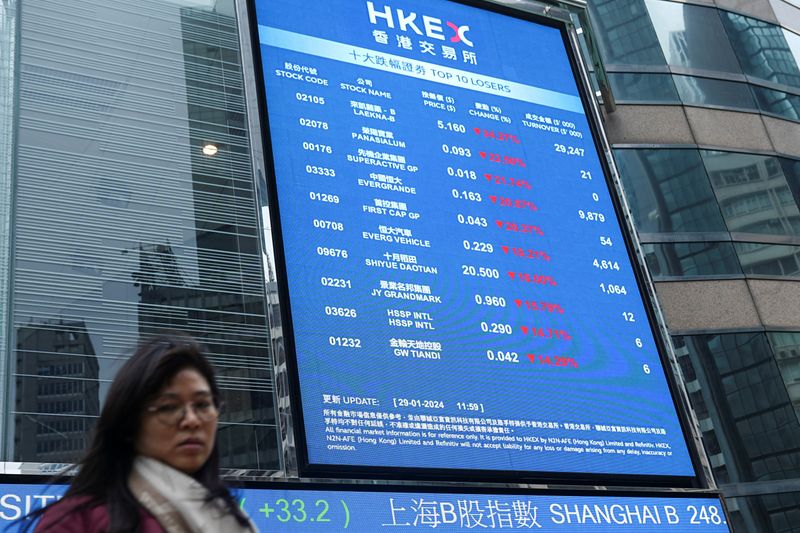
© Reuters. A woman walks in front of a screen displaying Evergrande’s stock prices among others outside the Exchange Square, after a court ordered the liquidation of China Evergrande Group, in Hong Kong, China January 29, 2024. REUTERS/Lam Yik/File photo
By Chuck Mikolajczak
NEW YORK (Reuters) -A gauge of global stocks fell on Friday and was set for a weekly decline that would snap seven straight weekly gains, while the dollar rose and was on track for its strongest week since mid-January, as U.S. inflation data has led to new hopes for interest rate cuts.
Data on Friday showed U.S. import prices increased marginally in February as a surge in the cost of petroleum products was partially offset by modest gains elsewhere, suggesting an improving inflation picture.
Equities struggled this week after readings on U.S. consumer prices and producer prices indicated inflation remains sticky, dampening expectations the U.S. Federal Reserve will cut rates by its June meeting.
Markets are pricing in a 59.2% chance for a rate cut of at least 25 basis points (bps) by the Fed in June, down from 59.5% in the prior session and 73.3% a week ago, according to CME’s FedWatch Tool.
The central bank is widely expected to hold rates steady at its policy meeting next week but investors will be watching the central bank’s economic projections, including its interest rate forecast.
“We seem in a period here where everyone knows rates eventually will be lowered. The expectation of when it happens keeps getting slightly pushed back, but investors still believe it will happen,” said Rick Meckler, partner at Cherry Lane Investments in New Vernon, New Jersey.
“It’s been a back-and-forth market as people reposition and consider whether some of the real winners have just gone a little bit too far, so you’re seeing them trade off.”
On Wall Street, the fell 190.89 points, or 0.49%, to 38,714.77, the lost 33.53 points, or 0.65%, to 5,116.95 and the lost 155.35 points, or 0.96%, to 15,973.17.
For the week, the S&P 500 lost 0.13%, the Dow shed 0.02% and the declined 0.73%.
In addition, a survey from the University of Michigan showed its preliminary reading on consumer sentiment and inflation expectations were little changed in March while a separate report said production at U.S. factories increased more than expected in February.
{{2126|The do gained 0.05% at 103.43, recouping some of the prior week’s decline with a gain of 0.71%, with the euro up 0.06% at $1.0889 on the session. weakened 0.13% at $1.273.
Against the Japanese yen, the dollar strengthened 0.49% to 149.05, despite expectations the Bank of Japan is expected to end its negative interest rate policy at its meeting next week.
MSCI’s gauge of stocks across the globe fell 5.07 points, or 0.66%, to 767.58, poised for its third straight daily decline, the longest streak since the start of the year, and down 0.48% on the week.
The index closed down 0.32%, while Europe’s broad index fell 7.42 points, or 0.37%.
The yield on benchmark U.S. 10-year notes was up 1 basis point at 4.308% after reaching 4.322%, its highest since Feb. 23. The 10-year yield has jumped 22 bps this week, the most since mid-October.
The 2-year note yield, which typically moves in step with interest rate expectations, rose 3.9 basis points to 4.7297% and has risen 24.6 bps for the week, its largest jump in two months.
Oil prices dipped, a day after topping $85 a barrel for the first time since November. The oil benchmarks were on track to close out the week with a gain of more than 3%. settled down 0.27% lower on the day at $81.04 a barrel and settled off 0.09% to $85.34 per barrel.











